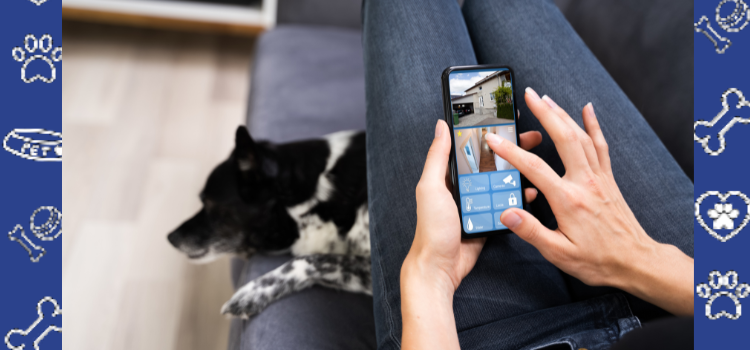How CCTV Can Help You Monitor ...

How CCTV Can Help You Monitor Your Pet’s Health and Wellbeing
As pet owners, we want the best for our furry companions, always aiming to ensure their health and happiness. While regular visits to the vet and daily routines can help keep your pet in good shape, there’s a modern tool that can add an extra layer of peace of mind: CCTV. In the age of smart technology, surveillance cameras designed for home security can double as an effective way to monitor your pet’s health and wellbeing. With the added benefit of a formal letter from PetCerts.com for Emotional Support Animals (ESA) or Psychiatric Service Dogs (PSD), you can further enhance your pet’s environment, especially in housing situations that require specific documentation.
Using CCTV to Keep an Eye on Your Pet’s Health
CCTV cameras, often used for home security, can be valuable for observing your pet when you're not at home. With high-definition video and real-time access via smartphones, these systems allow you to track your pet's activities, behavior, and physical condition, even when you're out and about.
- Observe Behavior Patterns
Pets can’t always communicate when they’re feeling unwell, but they often express discomfort or anxiety through their behavior. By using CCTV cameras, you can monitor how your pet is moving around, whether they’re eating and drinking properly, and if they’re behaving normally. Are they acting lethargic, excessively scratching, or avoiding certain areas? These subtle signs could point to health issues that may need attention from a veterinarian. With remote access to live footage, you can catch these signs early, without the need to interrupt your day. - Monitor Eating and Drinking Habits
Sometimes, pets will hide signs of illness, particularly when it comes to eating and drinking. With CCTV cameras positioned in your pet's eating area, you can keep track of how much food and water your pet is consuming. A sudden drop in appetite or a change in drinking habits can signal a variety of health concerns. Monitoring these habits through CCTV helps ensure your pet is staying properly nourished, or alerts you when a visit to the vet might be necessary. - Physical Mobility
Pets that are experiencing pain or discomfort may exhibit changes in their movement patterns. A pet that’s avoiding jumping, struggling to walk, or limping could be showing signs of arthritis or an injury. CCTV allows you to capture and review your pet’s mobility, helping you notice any signs of discomfort. Additionally, if your pet has an existing condition, being able to monitor their movements while you're away ensures that you can catch any flare-ups early on. - Stress and Anxiety
Pets, particularly dogs, can experience stress and anxiety for a number of reasons—new environments, loud noises, or separation anxiety when their owners leave. CCTV can give you a window into how your pet reacts when left alone. Are they pacing, whining, or exhibiting destructive behaviors? Understanding your pet’s emotional needs and stress levels can help you identify when they may need additional support or a change in their routine.
The Role of the PetCerts.com ESA/PSD Housing Letter
Alongside using CCTV for monitoring your pet's health, the presence of a formal letter from PetCerts.com for ESA or PSD pets is valuable in ensuring your pet has the best living environment. For many people with emotional or psychological challenges, having a pet as a companion can be incredibly beneficial. Emotional Support Animals (ESAs) and Psychiatric Service Dogs (PSDs) are recognized for their positive impact on individuals’ mental and emotional health.
In certain housing situations, pets may need to meet specific requirements to live with their owners. For example, some landlords or housing providers have policies that restrict pets, but individuals with ESA or PSD pets may be exempt from these restrictions if they have the appropriate documentation. This is where a formal ESA/PSD housing letter from PetCerts.com comes in. The letter provides proof that your pet is more than just a companion; it is an essential part of your health and well-being.
The combination of CCTV monitoring your pet’s physical and emotional needs and having a valid ESA/PSD housing letter ensures that both you and your pet can thrive in a safe and supportive environment. By understanding your pet’s health through surveillance, you can respond quickly to any issues that arise, and the housing letter ensures you have the legal rights to live with your support animal in various housing settings.
Why This Matters
The overall wellbeing of your pet is intertwined with your own mental and emotional health. For individuals with specific emotional or psychiatric needs, the companionship of an ESA or PSD can be life-changing. At the same time, ensuring that these pets are healthy, content, and comfortable is crucial for maintaining the benefits they offer.
By using CCTV to monitor your pet’s health, you’re taking a proactive step in providing the best care possible. Whether you’re concerned about physical health, eating habits, or emotional well-being, technology can help you stay on top of your pet’s condition. Coupled with the support provided by a PetCerts.com ESA/PSD housing letter, you can ensure that your pet is part of your living space, helping you manage both your health and theirs.
As technology continues to evolve, tools like CCTV can greatly enhance our ability to care for our pets, especially those who provide vital emotional and psychological support. Through monitoring your pet’s health and behavior with these systems, you can provide them with the care they need, when they need it. The ESA/PSD housing letter from PetCerts.com ensures that your pet can be there for you every step of the way, creating a safer and more supportive environment for both of you. Together, these tools can help make your pet’s living experience more comfortable and your bond even stronger.